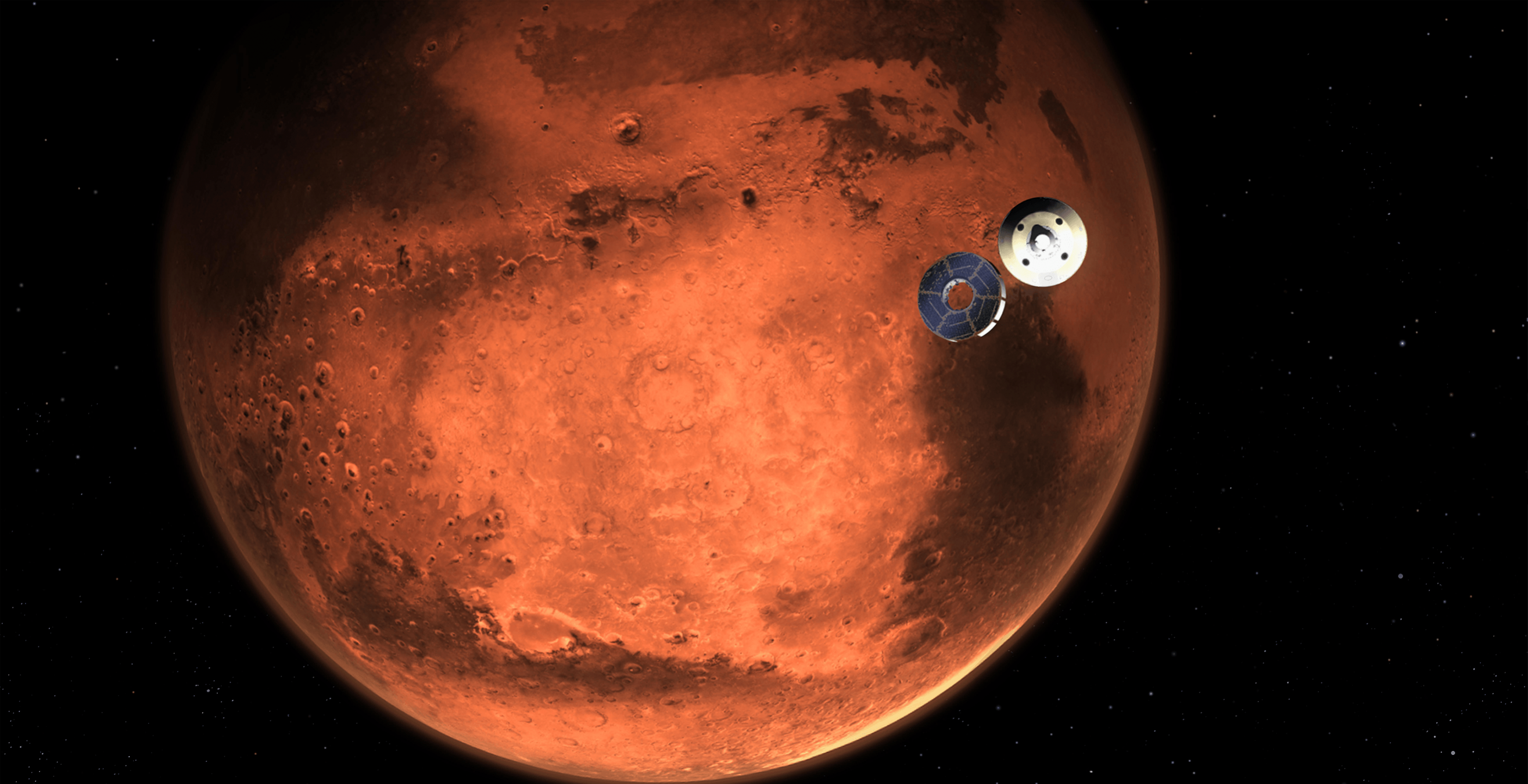After a journey of seven months and nearly 293 million miles, it all came down to seven excruciating minutes on a Thursday in February. Would the Perseverance rover, a two-ton, car-sized planetary explorer, be able to successfully land on Mars?
Around the world on February 18, 2021, thousands tuned in to the live feed from the mission control room at NASA’s Jet Propulsion Laboratory (JPL) in Southern California. There, a small, socially distanced crew monitored the rover’s descent once it hit the Mars atmosphere, traveling around 12,000 miles per hour. They checked to see whether the rover’s jets and parachute would guide it safely to the surface of the Red Planet.
The tension showed on every face. Years of hard work and the intellectual contributions of so many had led to that moment. It could all go wrong . . . and then —
“Touchdown confirmed!”
The control team erupted in cheers as they got word that the rover had reached Mars’ dusty red ground.
But the NASA crew weren’t the only scientists connected to Perseverance who held their breath during the descent.
As the rover began its trip toward the surface, Sanford Asher watched with his family from his home in Pittsburgh. A distinguished professor of chemistry at Pitt, he is a key member of a group of investigators who developed an ultraviolet laser, attached to the arm of Perseverance, designed to hunt for signs of ancient life on Mars.
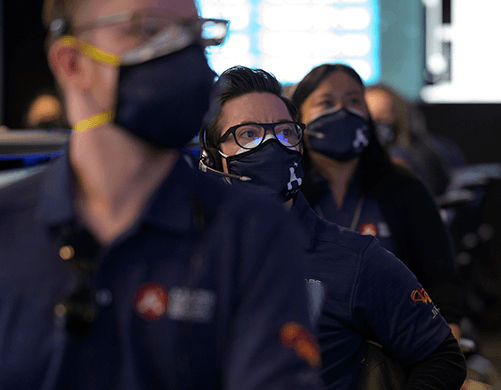 When the touchdown was announced, “We danced and jumped around,” he says.
When the touchdown was announced, “We danced and jumped around,” he says.
“I was quite aware there was a delay in the transmission between Mars and Earth and I realized it would be a disaster if we hadn’t heard anything after about 20 minutes. The bottom line, though, was that everything went great — no glitches, no nothing. It almost seemed too easy.”
Meanwhile, Emily Klonicki, her fiancé and their dog watched the landing from their home in California, where she projected the feed onto the wall and video-conferenced with colleagues. A Pitt alumna who graduated only three years ago, she’s part of the group that is responsible for the biological cleanliness of the rover — work that is meant to avoid any potentially harmful contamination of Mars.
“I was obviously excited because this was the first mission I had ever worked on,” she says. “It takes many years to develop a mission. To see it come together and work flawlessly was awesome.”
It wasn’t that long ago that Mars was just an abstraction, a distant red dot in the night sky. Its fiery hue inspired some ancient cultures to associate it with war and strife. But its position as one of our closest neighboring planets turned it into a symbol of possibility. In the 19th century, ever-stronger telescopes allowed viewers clearer glimpses of the Martian surface, revealing features that seemed at the time to resemble dried riverbeds on Earth. Popular culture imagined people hidden there, intelligent life forms, little green men. Scientists and lay people alike longed to uncover its secrets.
In the past five decades, however, visiting Mars has evolved from a dream into a reality—at least remotely. NASA’s Mars Exploration Program, of which the Perseverance rover is a part, has been gaining fascinating insights about the fourth planet from the sun since the 1990s. One day, it might reveal that life exists (or once existed) there, finally proving that we aren’t alone in the universe.
But the data the program gathers — and the technology developed to get it — may also shed light on some of Earth’s own mysteries, from the evolution of its earliest lifeforms to how to treat Alzheimer’s.
Pitt’s Asher and Klonicki are among the innovators who have contributed to the Mars mission. Driven by a thirst for knowledge and the thrill of discovery, their separate efforts are helping to answer some of humanity’s most enduring questions.
When Asher looks at the crisp color photo Perseverance took of itself and beamed back to Earth on April 6, 2021, he’s viewing, in a way, a tiny part of himself. That’s because a crucial piece of the technology enabling the rover to search the windswept landscape for signs of ancient life was developed and refined by him and his colleagues.
The device is called SHERLOC — which stands for Scanning Habitable Environments with Raman & Luminescence for Organics & Chemicals — and like the fictional sleuth its name recalls, this instrument is a detective.
SHERLOC’s job is to hunt for indications of ancient organic compounds embedded in the Martian rocks. To do that, it uses a type of chemical analysis known as Raman spectroscopy — a technique in which Asher is a pioneer.
Raman spectroscopy measures how substances scatter light shined on them by a laser, which allows scientists to identify their makeup and configuration. If any of the rocks show traces of organic compounds — as in chemical substances that may have been derived from living things — they can be scooped up and eventually brought back to Earth for more extensive analysis.

Interplanetary science wasn’t exactly what Asher had imagined while working on a PhD in chemistry at the University of California at Berkeley in the 1970s. That’s where the St. Louis native first fell in love with Raman spectroscopy. In those years, he says, it was an arcane field because the “Raman effect” — or the change in light’s wavelength when it bounces off molecules — was weak and very hard to measure.
All that would change in the 1980s and beyond with the development of more powerful lasers as light sources to create Raman scattering, among other advancements. Asher was able to get in on the ground floor of that work.
After he earned his doctorate, he and his wife, epidemiology researcher Nancy Day, soon found positions at the University of Pittsburgh. Asher has spent his career here, continuing to explore new areas of research using Raman spectroscopy.
The technique is a powerful tool for studying the shape and function of proteins, which, among many other things, play a key role in the development of disease. Mutations in certain components of proteins are known to lead to neurodegenerative illnesses like Alzheimer’s — diseases Asher and his lab have zeroed in on.
In Alzheimer’s patients, mutated parts of proteins clog the brain’s cells, damaging or destroying the way it functions. “Trying to understand why those proteins have gone bad in an irreversible way is a fundamental area of research for us,” he says. Armed with an answer to the “why,” scientists may be able to find a key to preventing or reversing the disease.
Another of his focus areas is using Raman to detect signs of explosives, such as those that might be planted by terrorists. Working with funding from the Office of Naval Research, the scientists in Asher’s Pitt lab have developed a way to detect traces of explosives from more than 15 feet away.
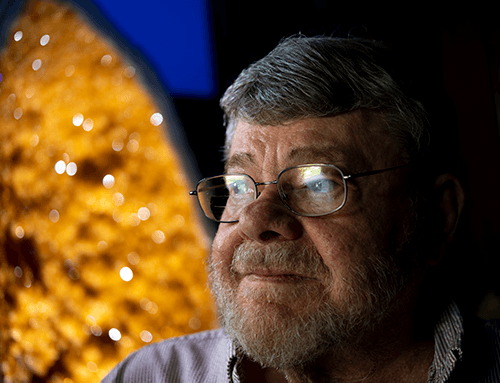
And then there’s his work on photonic crystals, which builds off of his spectroscopic research into how light and matter interact. He and his lab colleagues have applied the crystals, which reflect and channel light, to develop a special type of contact lens that can change color if a person with diabetes has high blood sugar levels.
Asher’s research at Pitt perfectly prepared him for his work as a co-investigator with SHERLOC at NASA. Detecting life on Mars might not seem directly connected to something like Alzheimer’s research, but with his and his colleagues’ application of the Raman light-scattering technique, exploring vastly different parts of the microbial landscape is possible — on both Earthly and Martian terrain.
Even though Perseverance has been operating on Mars now since February, Asher says the SHERLOC device has been functioning for only a few months. The rover’s systems had to be thoroughly tested first.
Now, however, Perseverance and its seven-foot-long mechanical arm outfitted with SHERLOC and other detectors are hard at work, zeroing in on tiny segments of the Martian surface. Data on the planet’s rocks and sediment are streaming back to Earth. And all the while, Asher and his colleagues at NASA’s JPL are monitoring the findings with excitement and hope.
Asher’s work focuses on potential life on Mars; Klonicki’s on the other hand, focused on ways to ensure that biological evidence of Earth’s own lifeforms stays off the Red Planet for now.
As a planetary protection engineer at JPL, her job is to help make sure that the spacecraft components heading to other planets and moons meet specific cleanliness requirements, and to prevent the potentially harmful consequences that could arise if samples from other worlds contaminated Earth upon their return. In other words, she works to keep Earth’s contaminants off of other planets and other planets’ contaminants off of Earth.
Her trajectory to this point has been nothing short of stellar.
She started college at Pitt in 2015, arriving from Lancaster, Pennsylvania, with the intention of majoring in microbiology. She joined her older sister, Addy (BUS ’16), who herself had followed in the footsteps of their father, Steve Klonicki, who had studied computer science at the University. Her initial aim after college was medical school. But then, as a sophomore, she became fascinated with environmental engineering. Klonicki began to assist research efforts in the laboratory of David Sanchez, an assistant professor of civil and environmental engineering, where work is underway on sustainable solutions to water and energy challenges. There, her focus and fascination helped her excel as she gained experience in bioelectrochemical experimentation and data analysis.

That same year, she and Addy, who studied finance and marketing, began to work together on a project that used microbial fuel cells (a system that creates an electrical current from the reactions of microorganisms or bacteria) as a cheap alternative for charging electronics in developing countries. The concept won them second place in the Randall Family Big Idea Competition, an annual showcase of the Pitt innovations with the most start-up potential.
Klonicki (A&S ’18) was later chosen by the Swanson School of Engineering as a University Innovation Fellow. Then, in her junior year, she interviewed with JPL for the planetary protection internship that got her working on Perseverance. She was offered the position on the spot and spent the summer designing and testing a protocol to qualify air filters on a system called MOXIE (Mars Oxygen In-Situ Resource Utilization Experiment).
“MOXIE collects CO2 (carbon dioxide) from the Martian atmosphere, then electrochemically splits the CO2 molecules into oxygen and carbon monoxide,” she says.
The technology demonstration could pave the way for equipment that future Mars missions could use to make the oxygen needed to help power a rocket to lift astronauts off the planet’s surface. It could also provide breathable air for those astronauts.
But as the system works on the alien planet, it expels oxygen, carbon dioxide and unused Martian atmosphere through three filtered ports on the side of the Perseverance rover. It was vital to ensure that microbes from Earth couldn’t stow away and then end up on Mars.
That summer led to another JPL internship after graduation to study how fungi behave in microgravity.
Klonicki was all set to start a PhD program in environmental engineering when, two days before her second internship ended, she was offered a full-time position at JPL. “I about fell out of my seat because there was zero indication I would be brought on.”
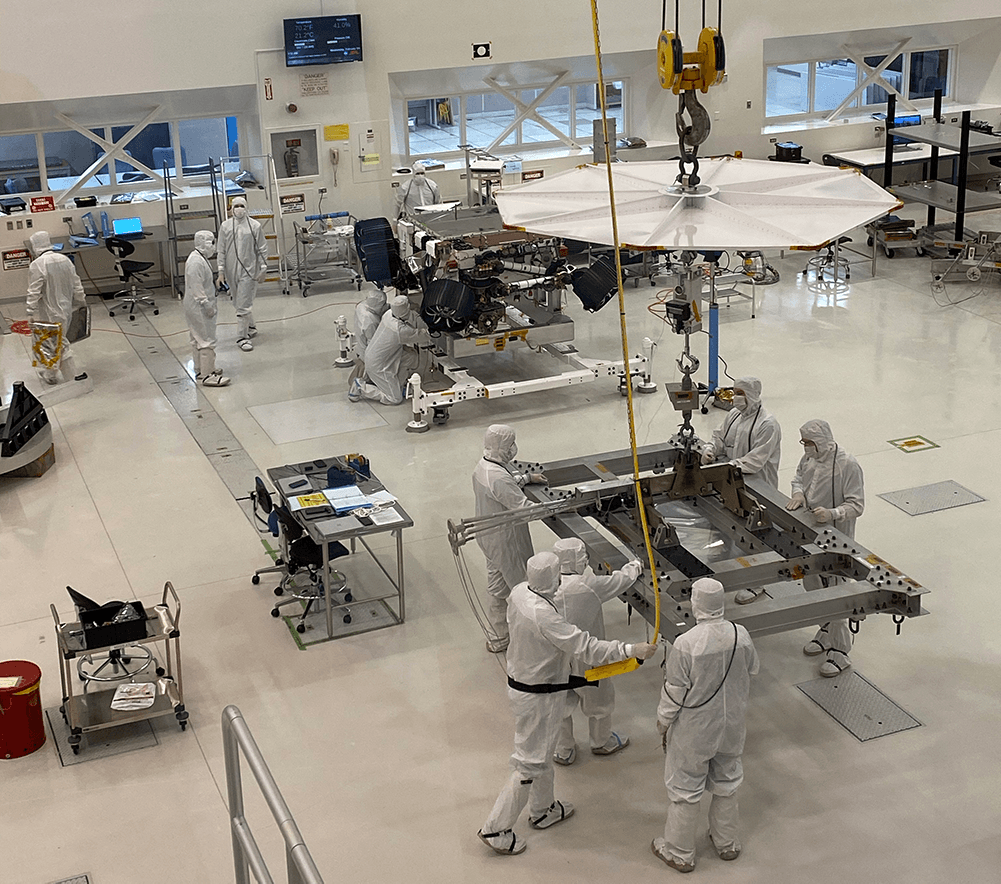
While she began her journey at JPL with Perseverance, her main efforts today focus on another NASA mission, this one aimed at Jupiter’s icy moon, Europa. She’s working on the Europa Clipper mission, a probe that will conduct multiple flybys of Europa. The mission aims to investigate whether the moon, with its internal global ocean, has conditions suitable for life.
One of Klonicki’s regular tasks is to pull on a protective suit, mask and gloves to enter a cleanroom that contains the actual flight hardware of the Clipper spacecraft, and then sample it to check for signs of bacterial spores.
Like Perseverance, before Clipper is launched into space, it will be cleaned with everything from heat treatment to isopropyl alcohol. As a practical matter, says Klonicki, it may be difficult to eliminate every microorganism on a piece of hardware going to space. The goal is to reduce the population of microorganisms to a level where it does not pose a contamination threat to the target body of interest or the planned scientific investigations. The conditions in space such as extreme temperatures, a lack of oxygen and harsh radiation assist with reducing the microbes on a spacecraft en route.
When she describes her planetary protection work to people, Klonicki says, “Typically they think this is a way of not harming the environment.” But there’s a bigger goal. “We want to have scientific integrity, to remove any sense of false positives” of mistakenly finding signs of life on other planets that accidentally came from Earth.
“You don’t want to have signs of life and then find out it was just a human contaminant.”
Klonicki is now preparing to embark on a new set of more terrestrial mysteries. There’s something about the unknown that seems to keep her going. Soon, she’ll start a new doctorate program at the University of California in Los Angeles, working with a professor who specializes in robotic exploration of the deep ocean — a place nearly as unknown as the observable universe. The work could serve to better inform researchers about the habitability of extraterrestrial oceans.

When most people think about the search for extraterrestrial life, they envision encounters with alien creatures. But scientists like Asher and Klonicki have more modest goals.
“I’m focused on finding out if there are small, potentially wiggling microbes on Europa,” Klonicki says. She thinks there may be organic compounds floating in Europa’s frigid seas, but “the likelihood of a Europa whale is pretty low.”
And even though Asher jokes that he joined the Perseverance mission “because they were going to finally find little green men and women,” he says more soberly a moment later, “If I had to guess, if there was ever life on Mars, it probably is very different from what we presently know.”
So, with such low-key expectations, why is it vital to explore places like Mars?
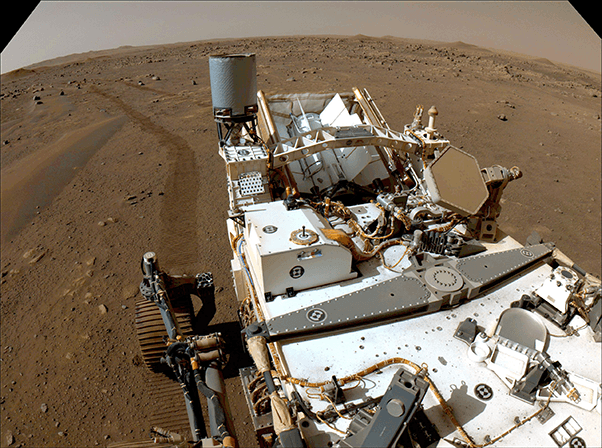 The purpose isn’t just to see whether life has arisen elsewhere. It’s also a way of understanding how life arose on Earth. Most of the oldest records of life on our own planet are gone, so finding simple fossil lifeforms or their chemical precursors on Mars could offer scientists a way to figuratively look back in time.
The purpose isn’t just to see whether life has arisen elsewhere. It’s also a way of understanding how life arose on Earth. Most of the oldest records of life on our own planet are gone, so finding simple fossil lifeforms or their chemical precursors on Mars could offer scientists a way to figuratively look back in time.
There’s also the hope that craft like Perseverance could help pave the way for future human expeditions to Mars. The rover’s technologies are testing a method for producing oxygen from the Martian atmosphere; looking for subsurface water; improving landing techniques; and characterizing weather, dust, and other potential environmental conditions that could affect future astronauts living and working on Mars.
As the data from Perseverance trickles in, Asher is proceeding thoughtfully. “We’re being very careful not to say anything stupid,” he says. “It’s very easy to get excited about things you’ve never seen before.”
Going forward, he’ll continue to pursue several research avenues, but he’s grateful for the chance to join the Mars mission.
“At the moment,” he says, “it’s hard to look very far forward because we’re starting just about at ground zero” in efforts to detect signs of biological substances on Mars. “If we don’t find life, that’s sort of sad, because it indicates life is probably uncommon. If we do find life, though, we may have to rethink who we are and what we are.”
Klonicki is cautiously optimistic about the chances of finding life somewhere in space.
“There are so many planetary bodies out there and suns that may have habitable zones,” she says.
“We just need to keep exploring in order to find what else is out there.”
This story is part of Pitt Magazine’s special Summer ’21 digital issue. Check back here regularly throughout the season for new stories!

